Johnny Cash, the “Man in Black,” is an icon of American music, and “I Walk The Line” stands as one of his most enduring and signature songs. Released in 1956, this track isn’t just a testament to fidelity; it’s a fascinating study in musical innovation born from limitation, a blend of country, rockabilly, and gospel influences, and a cornerstone of the rock and roll era emerging from Sun Records. This exploration dives deep into the history of “I Walk The Line Song”, revealing the story behind its creation, its unique musical structure, and its lasting impact on music history.
 Johnny Cash in a classic pose, highlighting his iconic look and guitar
Johnny Cash in a classic pose, highlighting his iconic look and guitar
Before “I Walk The Line” cemented his place in music history, Johnny Cash was finding his footing at Sun Records in Memphis, Tennessee. Under the guidance of the legendary Sam Phillips, Sun Records was a hotbed for burgeoning rock and roll talent, launching the careers of Elvis Presley, Carl Perkins, and Jerry Lee Lewis. As explored in the A History of Rock Music in 500 Songs podcast, Cash’s early sound was deeply intertwined with this rockabilly movement, even if his heart and voice leaned towards the country and gospel traditions he grew up with.
Cash, born J.R. Cash, honed his musical ambitions during his time in the Air Force. Upon returning stateside and settling in Memphis, he connected with Luther Perkins and Marshall Grant, forming the core of what would become the Tennessee Two (and later the Tennessee Three). Initially, their musical skills were raw, but their willingness to experiment and Cash’s remarkably resonant bass-baritone voice were their greatest assets. They started with gospel music, a genre close to Cash’s heart due to a profound childhood experience involving his late brother. However, Cash’s ambition stretched beyond gospel, fueled by the electrifying sounds emanating from Sun Records.
The pivotal moment came when Cash heard Elvis Presley’s “That’s All Right Mama,” released on Sun Records. This record sparked a realization: music could be made locally, and a career in music was attainable. Inspired, Cash and his bandmates sought out Sam Phillips. Despite initial setbacks and Phillips’ skepticism about gospel music’s commercial viability, Cash’s persistence and unique sound eventually won him an audition.
Phillips recognized Cash’s inherent star quality and encouraged him to explore more commercial, secular themes. This led to Cash penning “Hey Porter,” a song infused with the rhythmic pulse of the railway, which showcased the distinctive “boom-chick-a-boom” rhythm that would become a Cash trademark. This sound, born from the instrumental limitations of the Tennessee Two – lacking a drummer, Cash ingeniously used paper to dampen his acoustic guitar strings – was a defining element of his early Sun recordings. “Hey Porter,” paired with “Cry Cry Cry,” marked Cash’s entry into the charts, but it was the B-side of his second single that hinted at his true potential.
That B-side was “Folsom Prison Blues,” a song loosely inspired by a film and heavily influenced by Gordon Jenkins’ “Crescent City Blues” and Jimmie Rodgers’ “Blue Yodel #1.” “Folsom Prison Blues” became a hit, solidifying Cash’s rising star in country music and showcasing his knack for storytelling and darker themes. Around this time, Carl Perkins also signed with Sun, creating a dynamic, yet sometimes competitive, environment at the label.
Amidst this burgeoning success and label dynamics, Cash penned “I Walk The Line.” The inspiration struck him on the road, contemplating fidelity to his wife and his faith. The phrase itself might have been subtly influenced by Tennessee Ernie Ford’s hit “Sixteen Tons” and its lyric about “walking the line.” Cash envisioned “i walk the line song” as a slow, heartfelt ballad, a personal testament to commitment. However, Sam Phillips had a different vision.
Phillips, focused on the broader market appeal and the rock and roll energy he cultivated at Sun, believed “I Walk The Line” needed to be faster, more rhythmic, in line with Cash’s previous hits like “Hey Porter” and “Folsom Prison Blues.” He wanted a song that resonated universally, driven by a strong beat. Cash, while valuing the song deeply, also had another track, “Get Rhythm,” which he considered more in the rock and roll vein.
Despite their differing opinions, Cash and Phillips compromised, recording both a faster and slower version. To Cash’s initial dismay, Phillips released the faster rendition. Cash famously called Phillips, expressing his dislike for the faster tempo. However, the commercial success of “i walk the line song” quickly changed his perspective.
 A vintage jukebox, symbolizing the era in which "I Walk The Line" became a hit
A vintage jukebox, symbolizing the era in which "I Walk The Line" became a hit
“I Walk The Line” became a massive hit, reaching number one on the country jukebox chart and breaking into the pop top twenty. It sold over two million copies, proving Phillips’ commercial instincts correct and solidifying “i walk the line song” as a defining moment in Cash’s career. Beyond its commercial success, the song is musically remarkable.
“I Walk The Line” boasts an exceptionally unusual song structure. It features a key change after each verse, a technique rarely found in popular music. The song begins in F, ascends in fourths to B flat, then E flat, before descending back to B flat and finally F (an octave lower). This rising and falling musical arc mirrors the lyrical themes of balance, temptation, and the constant effort to “walk the line.” The cyclical nature of the melody reinforces the idea of continuous commitment and the daily struggle to maintain it.
Furthermore, the verses themselves are harmonically inventive within their simplicity. Each verse utilizes only three chords – tonic, subdominant, and dominant – the foundational chords of much of country and blues music. However, the verses begin with the dominant chord, creating a sense of musical unease and anticipation, departing from typical chord progressions where the tonic usually provides stability at the beginning. This unusual choice, possibly inspired by Cash’s experiments with reversed tape sounds, adds to the song’s unique and slightly unsettling character.
Another signature element of “I Walk The Line” is the humming that precedes each verse. While Cash offered various explanations, including using it to find the changing keys, it serves as an instantly recognizable intro and contributes to the song’s distinctive atmosphere. This combination of structural oddity, harmonic choices, and rhythmic drive makes “I Walk The Line” a far more sophisticated and unconventional recording than its seemingly simple country exterior might suggest. It’s a testament to the creative innovation that can emerge from musical limitations and a strong artistic vision.
“I Walk The Line” is more than just a song about fidelity; it is a testament to Johnny Cash’s artistry, Sam Phillips’ ear for commercial potential, and the fertile creative environment of Sun Records. It’s a song that defied convention, became a massive hit, and remains a cornerstone of Johnny Cash’s legacy and American music history. While Cash’s personal life and career would soon lead him away from Sun Records to Columbia Records and even greater superstardom, “I Walk The Line” stands as a powerful reminder of his Sun Records origins and the unique magic captured in that Memphis studio. This song continues to resonate, not just as a classic country tune, but as a testament to the enduring power of walking one’s own line, musically and personally.


